Journal of Computer and Communications, 2018, 6, 287-298
http://www.scirp.org/journal/jcc
ISSN Online: 2327-5227
ISSN Print: 2327-5219
Embedding and Extracting Digital Watermark
Based on DCT Algorithm
Haiming Li, Xiaoyun Guo
School of Computer Science and Technology, Shanghai University of Electric Power, Shanghai, China
How to cite this paper: Li, H.M. and Guo,
X.Y. (2018) Embedding and Extracting Dig-
ital Watermark Based on DCT Algorithm.
Journal of Computer and Communications,
6, 287-298.
https://doi.org/10.4236/jcc.2018.611026
Received: September 15, 2018
Accepted: November 25, 2018
Published: November 28, 2018
Copyright © 2018 by authors and
Scientific Research Publishing Inc.
This work is licensed under the Creative
Commons Attribution International
License (CC BY 4.0).
http://creativecommons.org/licenses/by/4.0/
Open Access
Abstract
The principle of digital watermark is the method of adding digital watermark
in the frequency domain. The digital watermark hides the watermark in digi-
tal media, such as image, voice, video, etc., so as to realize the functions of
copyright protection, and identity recognition. DCT for Discrete Cosine
Transform is used to transform the image pixel value and the frequency do-
main coefficient matrix to realize the embedding and extracting of the blind
watermark in the paper. After success, the image is attacked by white noise
and Gaussian low-pass filtering. The result shows that the watermark signal
embedded based on the DCT algorithm is relatively robust, and can effective-
ly resist some attack methods that use signal distortion to destroy the water-
mark, and has good robustness and imperceptibility.
Keywords
Digital Watermark, DCT Algorithm, White Noise, Gaussian Low-Pass
Filtering, Robustness, Imperceptibility
1. Introduction
Digital watermarking is an effective digital product copyright protection and
data security maintenance technology. It uses a digital marker to hide it in digital
products such as digital images, documents, and videos to prove its copyright.
And as evidence to prosecute illegal infringement, it thus becomes an effective
means of intellectual property protection and digital media security [1]. Digital
watermarking hides watermarks in digital media (images, voice, video, etc.) to
enable hiding the functions of transmission, storage, annotation, identification,
and copyright protection [2]. If there is no robustness requirement, the
processing of watermark and information camouflage technology is completely
consistent [3]. In most cases, we want to add information that is invisible or in-
287
Journal of Computer and Communications
DOI: 10.4236/jcc.2018.611026 Nov. 28, 2018
�
H. M. Li, X. Y. Guo
DOI: 10.4236/jcc.2018.611026
visible; in some specific situations where visible digital watermarks are used, the
copyright protection mark is not required to be hidden, and it is desirable that
the attacker does not destroy the quality of the data itself. The watermark cannot
be removed. Therefore, we can summarize functions of digital watermarking
technology into two aspects. On the one hand, it can be used to prove the origi-
nal author’s ownership of his work as evidence for the identification and prose-
cution of illegal infringement; on the other hand, the author can also realize the
work by detecting and analyzing the watermark in his digital product [4].
In this paper, the two-dimensional discrete cosine transform is used to realize
the embedding and extracting of the digital watermarking algorithm. The for-
ward DCT is used to convert the image block information into the coefficient
frequency domain matrix, and then the inverse DCT is used to transform the
watermarked coefficient matrix into the image block. This paper begins with a
detailed introduction to the basic knowledge related to digital watermarking and
classical algorithms, and briefly describes the DCT transforms that will be used
in this paper. After that, the traditional algorithms are improved accordingly.
According to the algorithm, in the intermediate frequency the watermark is em-
bedded in the coefficient to realize the adaptive embedding of the watermark. At
the end of the paper, the performance of the watermarking system is analyzed
and evaluated. After the embedding and extraction, the two methods of attack
and detection are performed. If the watermarked image cannot be seen and the
watermark is still identifiable, the watermark is proved to be robust and imper-
ceptible.
2. Digital Water Mark
2.1. Digital Watermark Meaning and Characteristics
Digital Watermarking technology hides some information that has special
meanings into digital media information such as text files, digital audio, video,
images, etc. through certain embedded algorithms, and requires that the em-
bedded watermark does not cause the appearance of the original data. And the
change of size does not affect the use value. When the watermark extraction de-
tected, the hidden information cannot be lost. In order to make digital water-
marks a trusted application system for digital product copyright protection and
integrity identification, embedded information entered into digital products
must have the following basic characteristics:
1) Concealment: After embedding the watermark, it will not affect the digital
work itself, there is no obvious quality degradation, and it can be perceived
by people.
2) Security and reliability: The embedded information and the embedded loca-
tion are encrypted and hidden, so that the illegal interceptor cannot obtain
relevant information.
3) Robustness: The way digital products suffer from some illegal or vandalism is
usually signal processing such as channel noise interference, filtering, edge
288
Journal of Computer and Communications
�
H. M. Li, X. Y. Guo
enhancement, jitter, A/D and D/A conversion, clipping, displacement, Scale
changes, multiple sampling and lossy compression coding. After such a
processing operation, the watermark must be able to be distinguished and
recognized.
4) Watermark capacity: Under the premise of ensuring multimedia quality, it is
possible to embed the author information of the work or the authentication
code of the product as much as possible. Only in this way can the function of
the watermark system be reflected in the event of a dispute.
5) Low error rate: The probability of detection errors in watermark detection
must be quite low, so that the performance of such a watermark system can
be truly guaranteed.
2.2. Common Watermarks
1) Visible watermark: The watermark can be seen, representing a kind of copy-
right information. It is mainly applied to the image, there are also applica-
tions in video and audio, and audible watermarks in audio.
2) Invisible watermark: This watermark is more widely used. When viewing an
image or video, the watermark is imperceptible and largely retains the value
of the digital work. But when there are problems like copyright disputes that
are difficult to solve, as long as the watermark can be extracted, the compli-
cated problem becomes very simple.
3) Robust watermark: mostly used to identify information. Its purpose is to
protect the digital copyright after it has been processed (filtered, noisy, re-
placed, compressed, etc.) and various malicious attacks.
4) Plaintext watermark: The original data must be detected when it is detected.
Its advantage is strong robustness. However, due to the dispersion of network
propagation information, the practical value of this watermark in the appli-
cation process is not broad.
5) Airspace watermark: Look for unimportant image bits in the carrier file, and
then directly superimpose the watermark information into the algorithm.
The aspect is very simple, but the robustness is not very strong.
6) Frequency domain watermark: The carrier file is mathematically transformed
so that it is converted from the time domain to the spatial domain, and then
the watermark information is embedded, and finally the inverse transform is
performed. At this time, the watermark already exists in any place of the car-
rier file. The mathematical transformation here is generally discrete cosine
transform (DCT), discrete Fourier transform (DFT), discrete wavelet trans-
form (DWT) and other algorithms.
3. Watermarking Algorithm
When the spatial domain algorithm is applied to the digital watermarking tech-
nology, when the digital artwork embedded in the watermark is subjected to
some common attacks, the watermark signal embedded therein is easily lost. In
289
Journal of Computer and Communications
DOI: 10.4236/jcc.2018.611026
�
H. M. Li, X. Y. Guo
DOI: 10.4236/jcc.2018.611026
view of this situation, the researchers have proposed the idea of embedding the
watermark in the transform domain. From the time domain to the transform
domain, mainly through some mathematical transformations, these mathemati-
cal transformations have discrete cosine transform (DCT) and discrete fourier
transform (DFT). At this time, some frequency domain coefficients of the image
are embedded in the watermark information. For this change, it means that the
signal of the watermark information may be released to any place in the entire
image space, and then the transformed frequency domain image is transformed
into a time domain watermarked carrier. After passing this series of transforma-
tions, the watermark signal will not be removed so easily.
3.1. Principle
Adding digital watermark principle in frequency domain: Adding digital water-
mark in frequency domain means transforming image into frequency domain by
some transform such as Fourier transform, discrete cosine transform and wave-
let transform, adding the watermark to the image in frequency domain and then
transform the image into a spatial domain by inverse transform. Compared with
airspace means, the frequency domain means is more occult and more resistant
to attack.
3.2. Advantage
The watermark information is trapped in the low frequency coefficient, which is
sensitive to the human eye, which will cause a significant drop in the quality of
the carrier image; embedding the high frequency coefficient will cause serious
damage to the watermark information embedded therein. Therefore, based on
the DCT domain watermark embedding intermediate frequency coefficients, a
good compromise between watermark transparency and robustness is achieved.
Based on the image watermarking algorithm of DCT transform domain, the
original image is firstly subjected to 8 × 8 block DCT transform. Then, the me-
thod of exchanging intermediate frequency coefficients is used, which is com-
monly used in traditional algorithms to improve the embedding of binary wa-
termarks, so that the larger value of the system is larger after the system is ex-
changed, and the smaller value is smaller, thereby obtaining stronger robustness.
3.3. DCT
DCT (DCT for Discrete Cosine Transform): The DCT for Discrete Cosine
Transform is a transform associated with the Fourier transform, which is similar
to the DFT for Discrete Fourier Transform, but uses only real numbers. The dis-
crete cosine transform is equivalent to a discrete Fourier transform of approx-
imately twice the length. This discrete Fourier transform is performed on a real
function, because the Fourier transform of a real function is still a real function,
in some variants, it need to move the input or output position by half a unit [5].
The two-dimensional DCT is taken as an example.
290
Journal of Computer and Communications
�
H. M. Li, X. Y. Guo
• By using the mapping transformation method, the image compression is
achieved by transforming each pixel in the image from one space to another,
and the signal is transformed from the spatial domain to the frequency do-
main after DCT. It’s a method of orthogonal transformation. It is a special
case in the image processing that is widely used in the Fourier transform. The
expanded function is a real function, and then discretized, that is a discrete
cosine transform.
• Like the Fourier transform, there are two kinds of positive and inverse trans-
formations.
Positive DCT: from spatial domain to frequency domain; inverse DCT: from
frequency domain to spatial domain.
3.4. Specific Formula
1) FDTC (positive transformation):
(
f
u v
,
)
=
( )
( )
c u c v
1
−
M N
1
−
∑ ∑
x
=
0
y
=
0
(
F ,
x y
)
cos
(
π
x
2
+
M
2
)
1 u
(
π
cos
)
1
v
y
2
+
N
2
u = 0, 1 M − 1, v = 0, 1 N − 1
2) IDCT (inverse transformation):
F
(
x,
)
y
1
−
M N
1
−
= ∑ ∑
u
=
0
v
=
0
( )
c u c v f u v
,
( )
(
)
cos
(
π
x
2
+
M
2
)
1
u
(
π
cos
)
1
v
y
2
+
N
2
x = 0, 1 M − 1 y = 0, 1 N − 1
3) Simplified formula
(1)
(2)
(
F u v
,
)
=
)
T
A f x y A
(
,
(3)
when M = N, the DCT transform can be expressed as a matrix multiplied form,
where A is in the for
A
=
1
2
2
2
N
N
N
N
[
[
[
[
cos
(
N
1)
2)
−
)
)
)
)
)
)
1
−
2
2
2
2
2
2
N
N
N
N
N
N
N
N
cos
cos
)
1
π
)
1
π
π
)
1 3
(
(
cos 2
(
(
cos 2
1
(
cos 3
π
(
cos 6
1
(
π
(
π
)
1
−
π
(
(
f x y is a digital image matrix of M N∗
that is the pixel value of the point (
put 8 × 8 pixels.
,F x y is the frequency domain sampled value, and the coordinates of the
output 8 × 8 transform result.
and the spatial sampled value,
,x y , which is the coordinates of the in-
)(
1 2
)
1
π
(4)
cos
cos
2
N
2
N
2
N
(
(
(
(
N
−
N
−
N
−
π
,
)
(
)
)
)
)
)
4. Watermark Embedding
• The image matrix
(
f x y which need to be embedded in the watermark is
divided into 8 × 8 image blocks, and the image block is subjected to DCT
transformation to obtain a frequency domain coefficient matrix
(
),F u v .
)
,
DOI: 10.4236/jcc.2018.611026
291
Journal of Computer and Communications
�
H. M. Li, X. Y. Guo
• Selecting algorithm to determine frequency domain coefficients and then to
make the watermark embedded, that is the selected frequency domain coeffi-
cients are modified to form a new frequency domain coefficient matrix.
There are two basic methods for modifying the coefficients, as shown in
formula (5) and formula (6):
Addition principle F
′ =
Multiplication principle
F
′ =
F
+ ∗
F a W
(
1
∗ + ∗
a W
(5)
)
(6)
Among:
“F” in the formula denotes the frequency domain coefficient before modifica-
tion
“F” denotes the modified frequency domain coefficient
“W” denotes the embedded watermark information
“a” denotes the embedded strength of the watermark, and “a” determines the
amplitude of the frequency domain coefficient to be modified.
• Perform IDCT on the new frequency domain coefficient matrix
F u v to
obtain an 8 × 8 image block containing the watermark, and replace the orig-
inal image block to obtain the watermarked image
Figure 1 is a watermark embedded block diagram.
)
,m x y .
(
(
)
,
'
5. The Extracting of the Watermark
Watermark Extraction Algorithm
• The extraction of watermark is the inverse process of the watermark embed-
,m x y containing the watermark and the
(
f x y are respectively DCT transformed to obtain the
ding algorithm [6]. The image
original image
frequency domain coefficient matrix
),M u v and
),M u v
.
(
)
(
(
)
,
′
• The selected frequency domain coefficients are modified to form a new fre-
quency domain coefficient matrix. Modify the coefficient formula (7):
N p q
,
(
)
=
(
M u v M u v
,
−
,
'
(
)
(
)
)
b
(7)
DOI: 10.4236/jcc.2018.611026
Figure 1. Watermark embedding block diagram.
292
Journal of Computer and Communications
�
H. M. Li, X. Y. Guo
• Perform IDCT on the new frequency domain coefficient matrix
,N p q to
obtain an 8 × 8 image block containing a watermark, and replace the original
image block to obtain an image
Figure 2 is a Watermark extraction block diagram.
,
(
n p q containing the watermark.
)
(
)
6. Watermark Attack Detection
The so-called attack on the watermark refers to the destruction of the watermark,
including smearing, shearing, scaling, rotation, compression, noise addition, fil-
tering, and the like. Digital blind watermarking is not only about agility, but also
defensive. The imperceptibility and robustness of digital blind watermarks are
mutually exclusive [7].
6.1. White Noise
Image noise causes random signal interference during image acquisition or
transmission, hindering people’s understanding and analysis of the image. Image
noise is often viewed as a multidimensional random process, so the method of
describing noise can be borrowed from the description of a random process.
White noise refers to the noise energy contained in a band of equal bandwidth
over a wide frequency range. It is a random signal or stochastic process with a
constant power spectral density. In other words, the power of this signal is the
same in each frequency band. Since white light is a mixture of monochromatic
lights of various frequencies (colors), the property of this signal with a flat power
spectrum is called “white”. This signal is therefore also referred to as white noise
[8] [9].
6.2. Gaussian Low-Pass Filtering
Gaussian filtering is a linear smoothing filter that is suitable for eliminating
Gaussian noise and is widely used in the noise reduction process of image
processing. In layman’s terms, it’s the process of weighted averaging of the entire
image, the value of each pixel is obtained by weighted averaging of itself and
other pixel values in the neighborhood [8].
DOI: 10.4236/jcc.2018.611026
Figure 2. Watermark extraction block diagram.
293
Journal of Computer and Communications
�
H. M. Li, X. Y. Guo
DOI: 10.4236/jcc.2018.611026
Low-pass filtering is used to smooth the image. The goal of the low-pass filter
is to reduce the rate of change of the image. For example, replace each pixel with
the mean of the pixels around the pixel. This makes it possible to smooth and
replace areas where the intensity changes significantly [10] [11]. The difference
between low-pass filtering and Gaussian filtering is that in low-pass filtering, the
weight of each pixel in the filter is the same, that is, the filter is linear. The
weight of the pixels in the Gaussian filter is proportional to the distance from the
center pixel.
6.3. Attack Detection
6.3.1. Testing
Digital watermarks have many features, but the basic features are as follows:
• Imperceptibility: The so-called imperceptible refers to the meaning of two
aspects, one refers to the invisibility of the human eye, and the other refers to
the statistical method cannot recover the watermark pattern of our embed-
ded side.
• Robustness: Robustness refers to a system that can maintain certain perfor-
mance characteristics under certain parameter changes, such as attacks and
input errors. It can be classified into stable robustness and performance ro-
bustness [12]. In the specific context of this article, robustness refers to the
ability to detect watermarks from watermarked images after noise attacks,
low-pass high-pass filtering, geometric distortion, etc. Robustness for water-
marks. It is a very important feature.
• Validity, effectiveness is mainly for the watermark system, it is a probability
value, which characterizes the ability of us to detect the watermark. Of course,
the larger the value, the better. But when it is closer to 100%, the more we
have to sacrifice on other features, the more we have a trade-off, and some-
times we sacrifice some effectiveness based on our focus [13].
Fair algorithm comparison and performance evaluation between different
digital watermarking systems are of great significance for the standardization of
digital watermarks and the practical application of watermarks [14]. The key to
performance evaluation of the watermarking system is to establish an evaluation
benchmark. The criteria for evaluating the watermark system include not only
the evaluation of robustness, but also the subjective or quantitative evaluation of
the distortion introduced by the watermark processing [15] [16]. In other words,
there needs to be a trade-off between the robustness and invisibility of the wa-
termark.
6.3.2. Image and Watermark
In this paper, the robustness of the first feature of digital watermarking is tested.
White noise and Gaussian low-pass filtering are selected as the attack. The wa-
termarked image is extracted and compared with the unaffected watermark.
• Original image and watermark as shown in Figure 3 and Figure 4
• Adding the watermarked image and the extracted watermark
294
Journal of Computer and Communications
�

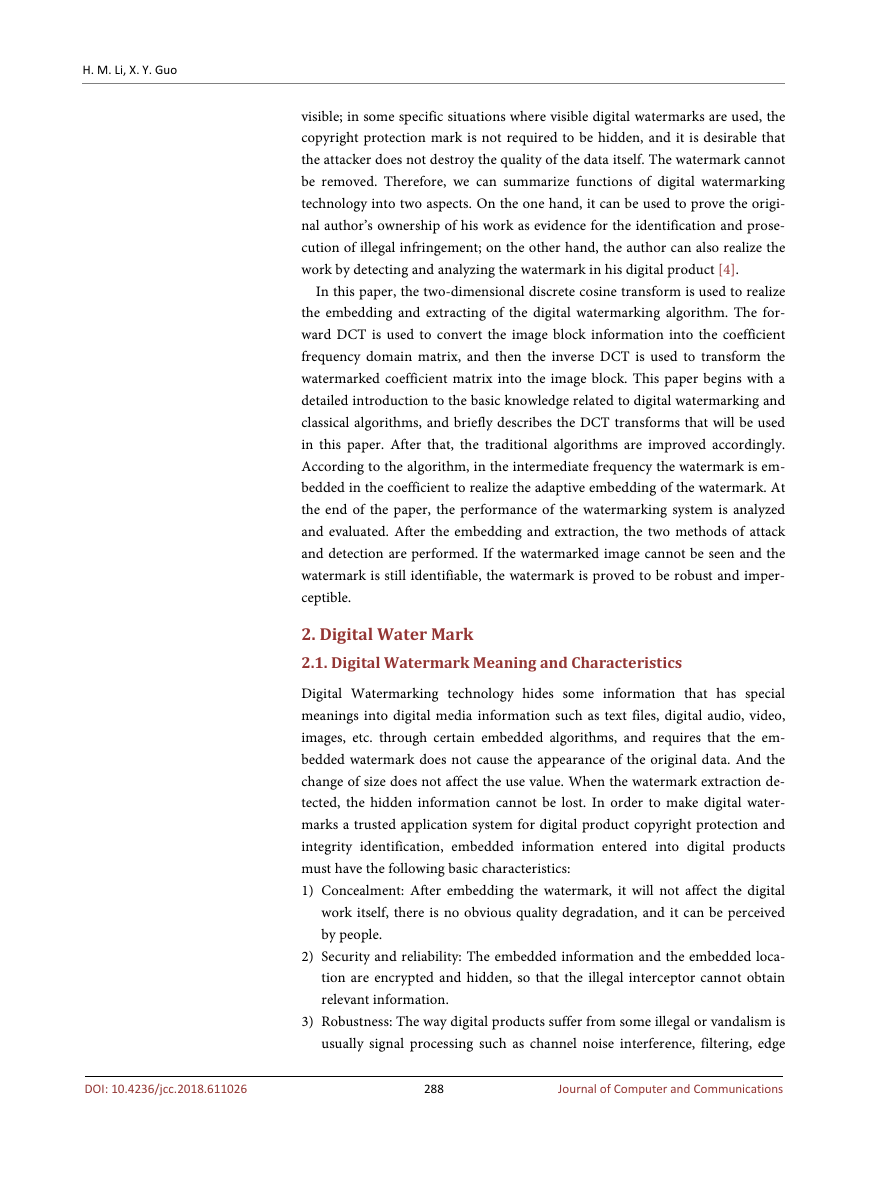

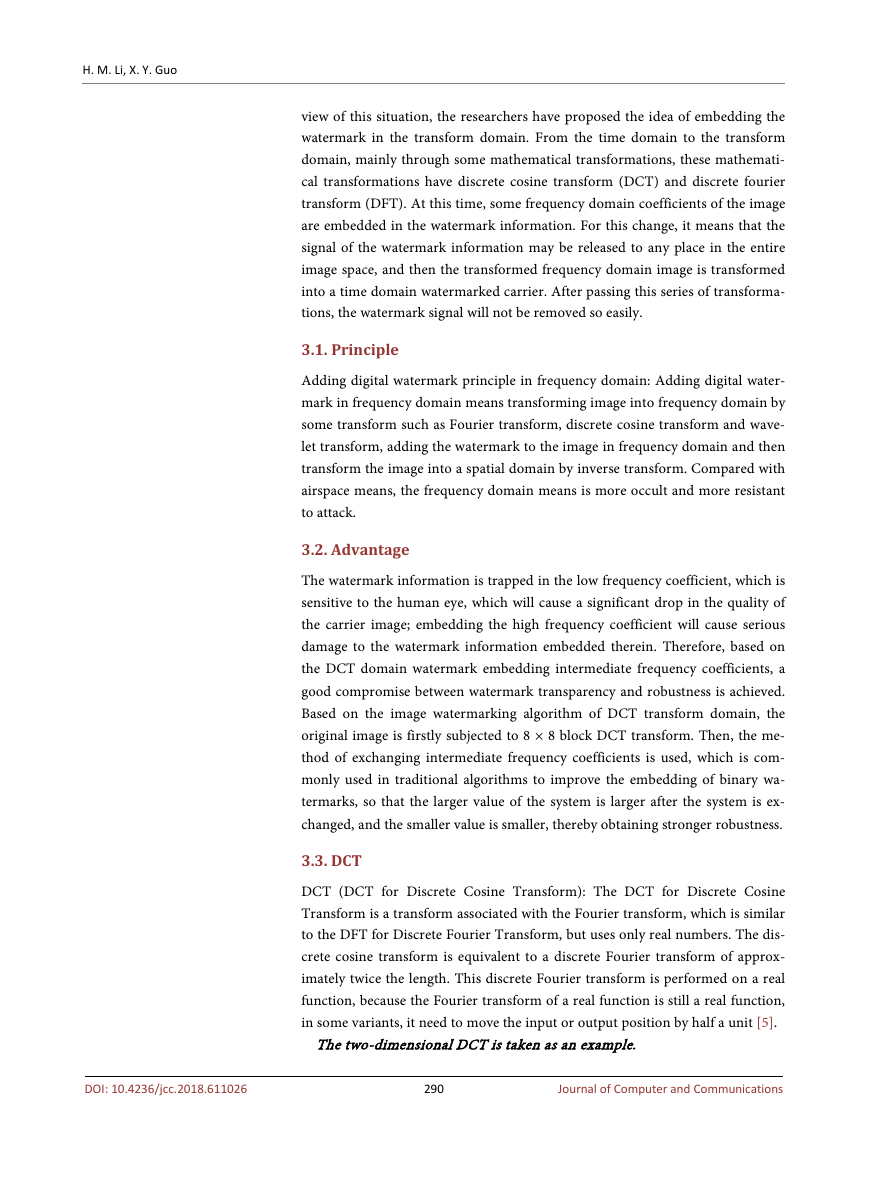
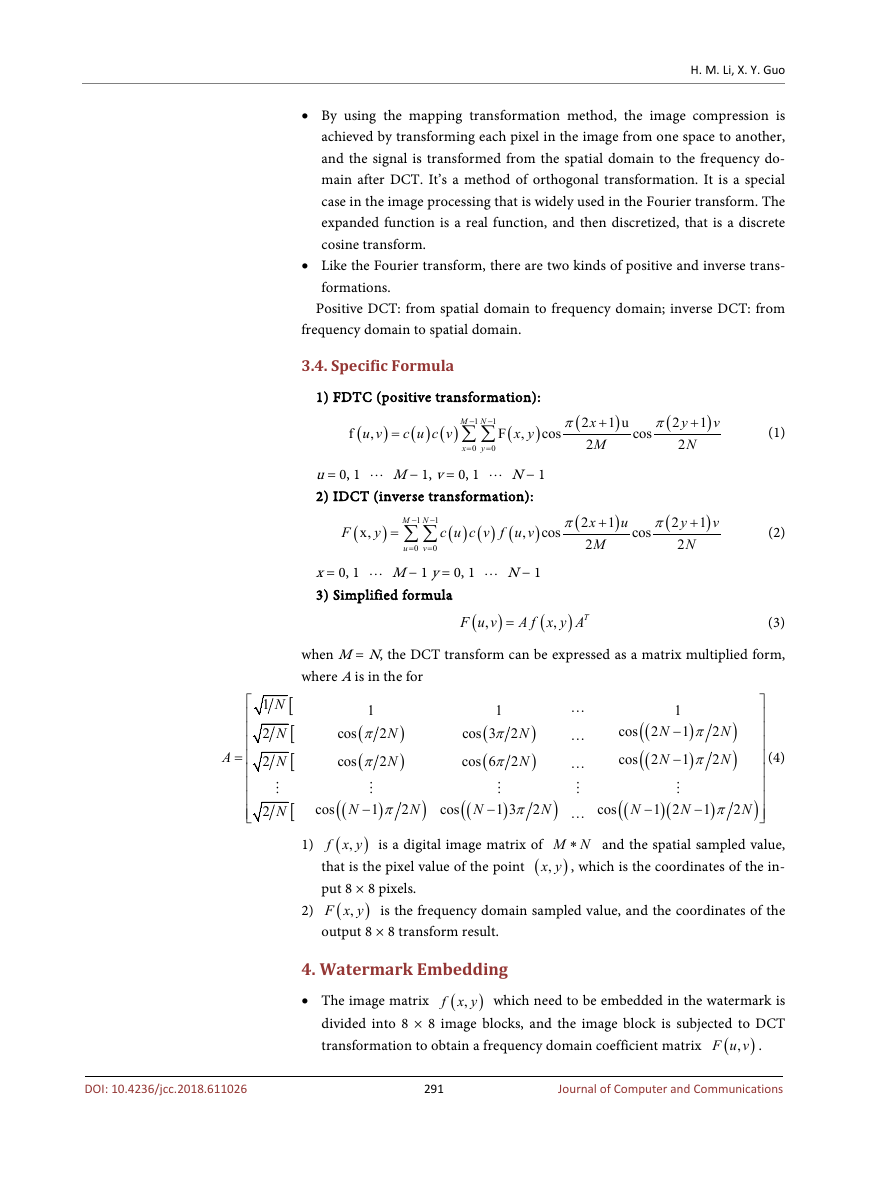
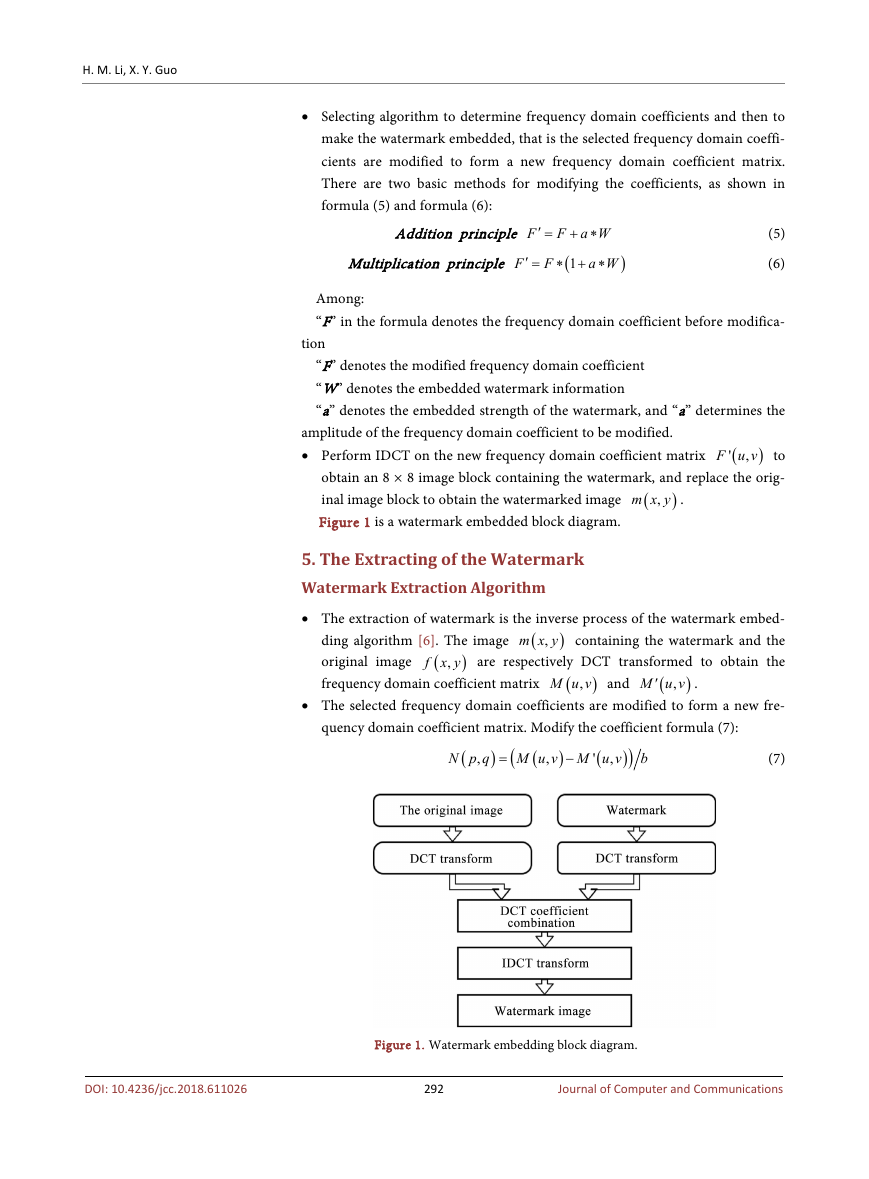
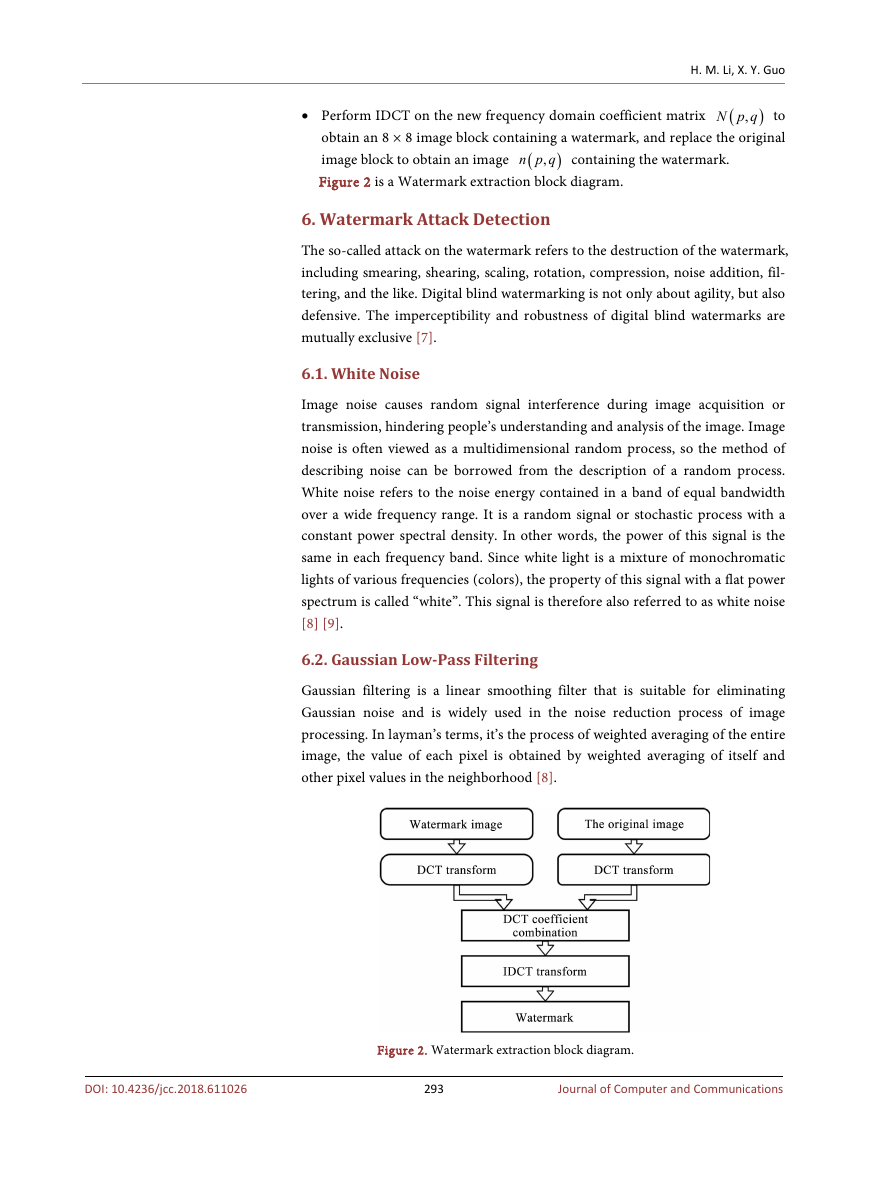









 2023年江西萍乡中考道德与法治真题及答案.doc
2023年江西萍乡中考道德与法治真题及答案.doc 2012年重庆南川中考生物真题及答案.doc
2012年重庆南川中考生物真题及答案.doc 2013年江西师范大学地理学综合及文艺理论基础考研真题.doc
2013年江西师范大学地理学综合及文艺理论基础考研真题.doc 2020年四川甘孜小升初语文真题及答案I卷.doc
2020年四川甘孜小升初语文真题及答案I卷.doc 2020年注册岩土工程师专业基础考试真题及答案.doc
2020年注册岩土工程师专业基础考试真题及答案.doc 2023-2024学年福建省厦门市九年级上学期数学月考试题及答案.doc
2023-2024学年福建省厦门市九年级上学期数学月考试题及答案.doc 2021-2022学年辽宁省沈阳市大东区九年级上学期语文期末试题及答案.doc
2021-2022学年辽宁省沈阳市大东区九年级上学期语文期末试题及答案.doc 2022-2023学年北京东城区初三第一学期物理期末试卷及答案.doc
2022-2023学年北京东城区初三第一学期物理期末试卷及答案.doc 2018上半年江西教师资格初中地理学科知识与教学能力真题及答案.doc
2018上半年江西教师资格初中地理学科知识与教学能力真题及答案.doc 2012年河北国家公务员申论考试真题及答案-省级.doc
2012年河北国家公务员申论考试真题及答案-省级.doc 2020-2021学年江苏省扬州市江都区邵樊片九年级上学期数学第一次质量检测试题及答案.doc
2020-2021学年江苏省扬州市江都区邵樊片九年级上学期数学第一次质量检测试题及答案.doc 2022下半年黑龙江教师资格证中学综合素质真题及答案.doc
2022下半年黑龙江教师资格证中学综合素质真题及答案.doc